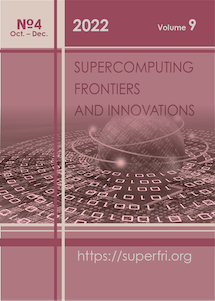Hybrid Dynamic Mesh Redistribution – Immersed Boundary Method for Acoustic Simulation of Flow Around a Propeller
DOI:
https://doi.org/10.14529/jsfi220407Keywords:
moving adaptive mesh, immersed boundary method, drone rotor, rotor acoustics, unstructured mesh, turbulent flowAbstract
A novel hybrid dynamic mesh redistribution – immersed boundary method for simulation of turbulent flows around rotating obstacles of complex geometry and analysis of tonal acoustics is proposed. The feasibility of the approach is demonstrated by considering a drone propeller problem. The results of three-dimensional Reynolds-averaged Navier–Stokes simulations using the proposed approach are compared to the results of body-fitted unstructured simulations in noninertial reference frame. The dynamic mesh redistribution method allows the reposition of mesh points taking into account the shape of the moving body while retaining the mesh topology. The cell size and quality of the dynamically redistributed mesh strongly depend on the curvature of the body surface. The position and shape of the moving obstacle is prescribed by a distance function defined on an adaptive octree. The results of simulations using the proposed method are in good agreement with both the results of body-fitted simulations and the experimental data.
References
Abalakin, I.V., Zhdanova, N.S., Kozubskaya, T.K.: Immersed boundary method implemented for the simulation of an external flow on unstructured meshes. Math Models Comput Simul. 8, 219–230 (2016). https://doi.org/10.1134/S2070048216030029
Zhdanova, N.S., Gorobets, A.V., Abalakin, I.V.: Supercomputer simulations of fluid-structure interaction problems using an immersed boundary method. Supercomputing Frontiers and Innovations 5(4), 78–82 (2018). https://doi.org/10.14529/jsfi180408
Abalakin, I.V., Bahvalov, P.A., Doronina, O.A., et al.: Simulating Aerodynanics of a Moving Body Specified by Immersed Boundaries on Dynamically Adaptive Unstructured Meshes. Math. Models Comput. Simul. 11(1), 35–45 (2019). https://doi.org/10.1134/S2070048219010034
Abalakin, I.V., Duben, A.P., Zhdanova, N.S., et al.: Immersed Boundary Method on Deformable Unstructured Meshes for Airfoil Aeroacoustic Simulation. Comput. Math. and Math. Phys. 59(12), 2046–2059 (2019). https://doi.org/10.1134/S0965542519120029
Tsvetkova, V.O., Abalakin, I.V., Bobkov, V.G., et al.: Simulation of the Flow near a Rotating Propeller on Adaptive Unstructured Meshes Using the Immersed Boundary Method. Math. Models Comput. Simul. 14(2), 224–240 (2022). https://doi.org/10.1134/S2070048222020168
Bobkov, V.G., Vershkov, V.A., Kozubskaya, T.K., Tsvetkova, V.O.: Deformation Technique of Unstructured Mesh Deformation to Find the Aerodynamic Characteristics of Bodies at Small Displacements. Math Models Comput Simul. 13, 986–1001 (2021). https://doi.org/10.1134/S2070048221060028
Dervieux, A., Mesri, Y., Alauzet, F., et al.: Continuous mesh adaptation models for CFD. Computational fluid dynamics journal 16(4), 346–355 (2008).
Tang, J., Cui, P., Li, B., et al.: Parallel hybrid mesh adaptation by refinement and coarsening. Graphical Models 111, 101084 (2020). https://doi.org/10.1016/j.gmod.2020.101084
Steger, J., Dougherty, F.C., Benek, J.A.: A chimera grid scheme. Advances in Grid Generation 5, 59–69 (1983).
Brandt, B.: Small-scale propeller performance at low speed, Master thesis, University of Illinois at Urbana-Champaign, 2005.
Brandt, J.B., Selig, M.S.: Propeller performance data at low Reynolds numbers. AIAA Paper 2011-1255 (2011).
Bobkov, V., Gorobets, A., Kozubskaya, T., et al.: Supercomputer Simulation of Turbulent Flow Around Isolated UAV Rotor and Associated Acoustic Fields. In: Voevodin, V., Sobolev, S. (eds) Supercomputing. RuSCDays 2021. Communications in Computer and Information Science, vol. 1510. Springer, Cham (2021). https://doi.org/10.1007/978-3-030-92864-3_20
Spalart, P.R., Allmaras, S.R.: A One-Equation Turbulence Model for Aerodynamic Flows. 30th Aerospace Sciences Meeting & Exhibit, January 6–9, 1992, Reno, NV, AIAA Paper 92-0439. https://doi.org/10.2514/6.1992-439
Abalakin, I.V., Anikin, V.A., Bakhvalov, P.A., et al.: Numerical Investigation of the Aerodynamic and Acoustical Properties of a Shrouded Rotor. Fluid Dyn. 51(3), 419–433 (2016). https://doi.org/10.1134/S0015462816030145
Abalakin, I., Bakhvalov, P., Kozubskaya, T.: Edge-based reconstruction schemes for unstructured tetrahedral meshes. Int. J. Numer. Meth. Fluids 81(6), 331–356 (2016). https://doi.org/10.1002/fld.4187
Bakhvalov, P.A., Kozubskaya, T.K.: Construction of edge-based 1-exact schemes for solving the Euler equations on hybrid unstructured meshes. Comput. Math. Math. Phys. 57(4), 680–697 (2017). https://doi.org/10.1134/S0965542517040030
Bakhvalov, P., Kozubskaya, T.: EBR-WENO scheme for solving gas dynamics problems with discontinuities on unstructured meshes. Comput. Fluids 157, 312–324 (2017). https://doi.org/10.1016/j.compfluid.2017.09.004
Garanzha, V., Kudryavtseva, L.: Hypoelastic Stabilization of Variational Algorithm for Construction of Moving Deforming Meshes. In: Evtushenko Y., Jacimovic M., Khachay M., et al. (eds) Optimization and Applications. OPTIMA 2018. Communications in Computer and Information Science, vol. 974, pp. 497–511. Springer (2019). https://doi.org/10.1007/978-3-030-10934-9_35
Kozubskaya, T.K., Kudryavtseva, L.N., Tsvetkova, V.O. Anisotropic Adaptation of Moving Unstructured Mesh to Bodies of Complex Shapes Described by an Interpolation Octree. Comput. Math. and Math. Phys. 62, 1590–1601 (2022). https://doi.org/10.1134/S0965542522100074
Frazza, L.: 3D anisotropic mesh adaptation for Reynolds Averaged Navier–Stokes simulations. Modeling and Simulation. Sorbonne Université, thesis (2018)
Kaporin, I.E., Milyukova, O.Yu.: MPI+OpenMP implementation of the BiCGStab method with explicit preconditioning for the numerical solution of sparse linear systems. Numerical methods and programming 20, 516–527 (2019). https://doi.org/10.26089/NumMet.v20r445
Soukov, S.A.: Combined signed distance calculation algorithm for numerical simulation of physical processes and visualization of solid bodies movement. Scientific Visualization 12(5), 86–101 (2020). https://doi.org/10.26583/sv.12.5.08
Garimella, R., Swartz, B.: Curvature Estimation for Unstructured Triangulations of Surfaces (2015)
Amenta, N., Choi, S., Kolluri, R.K.: The power crust. Proceedings of the sixth ACM symposium on Solid modeling and applications (SMA ’01), pp. 249–266 (2001) https://doi.org/10.1145/376957.376986
Gorobets, A.V.: Parallel Algorithm of the NOISEtte Code for CFD and CAA Simulations. Lobachevskii Journal of Mathematics 39(4), 524–532 (2018). https://doi.org/10.1134/S1995080218040078
Kozubskaya, T., Kudryavtseva, L., Tsvetkova, V.: Unstructured Mesh Adaptation for Moving Bodies in Immersed Boundary Methods. 14th WCCM-ECCOMAS Congress 2020, January 11–15, 2021. https://doi.org/10.23967/wccm-eccomas.2020.353
Downloads
Published
How to Cite
Issue
License
Authors retain copyright and grant the journal right of first publication with the work simultaneously licensed under a Creative Commons Attribution-Non Commercial 3.0 License that allows others to share the work with an acknowledgement of the work's authorship and initial publication in this journal.

